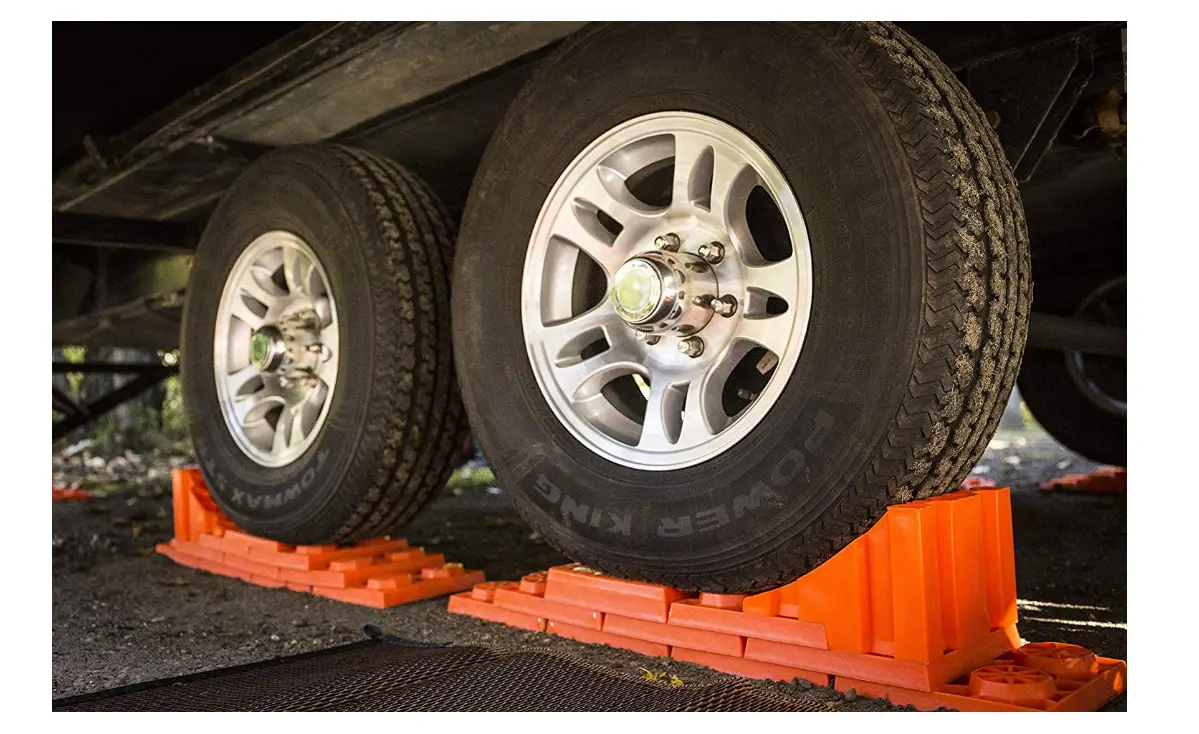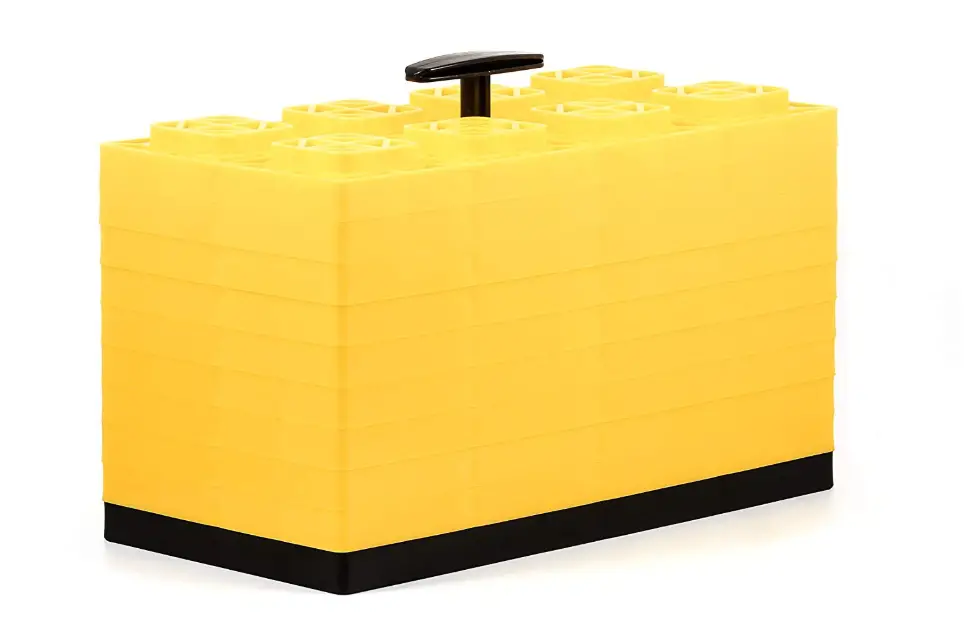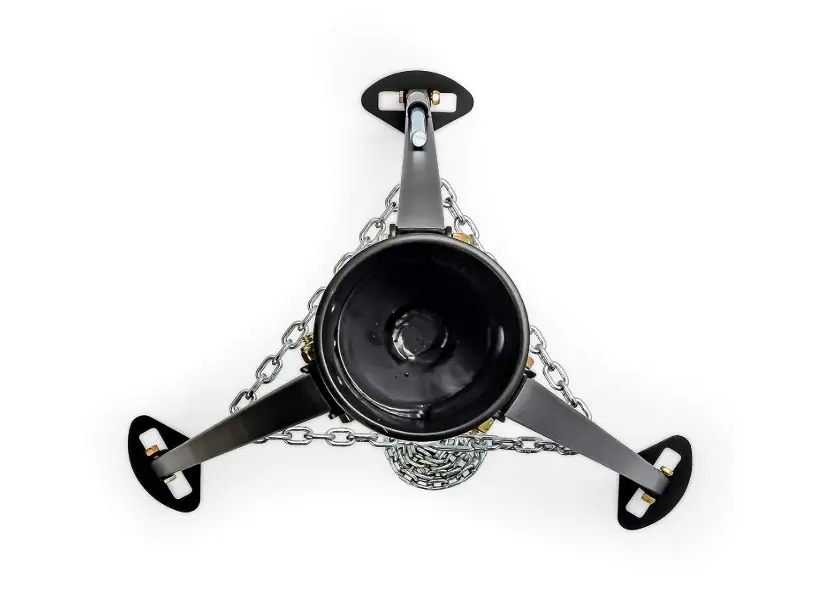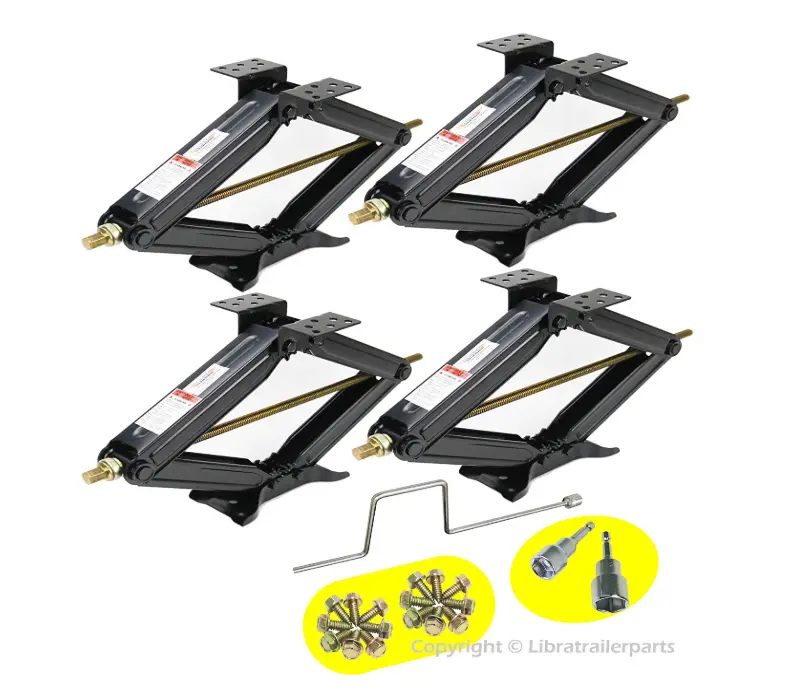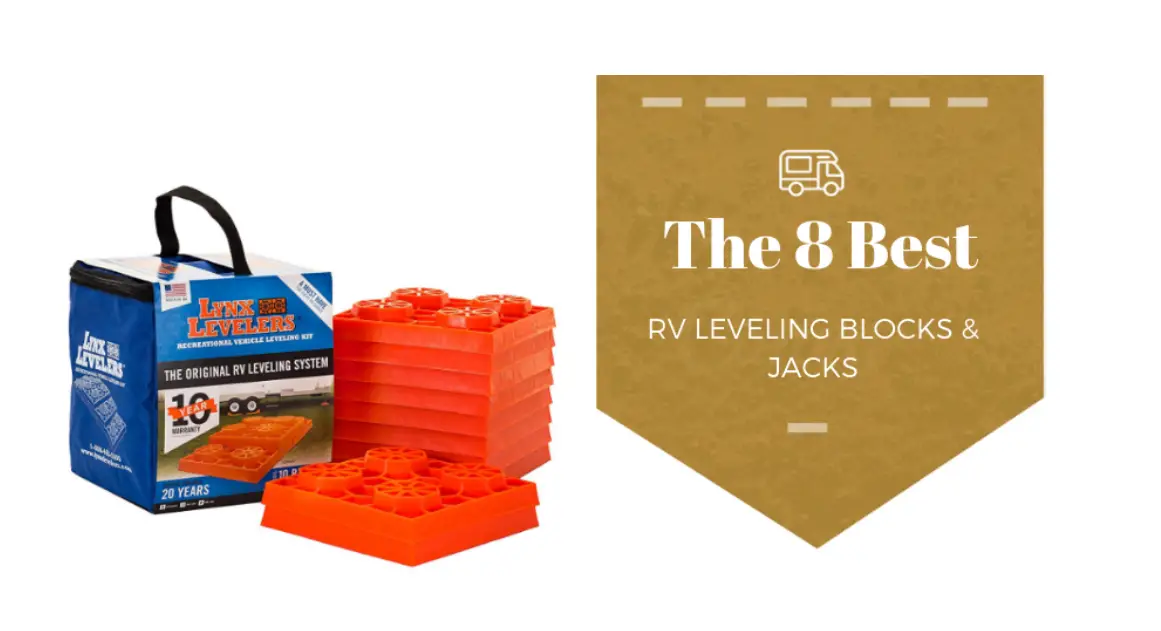
8 Best RV Leveling Blocks & Jacks
When you’re traveling around in an RV, you might find that you’re not always parked on perfectly level ground. This is especially true if you’re often camping and have to park your RV on an unpaved road.
RV leveling blocks and jacks are necessary for a number of reasons. If you’re constantly traveling, whether to campgrounds or the unexplored wilderness, you will often have trouble finding perfectly level ground to park on. As such, you’ll need to use leveling blocks to adjust your RVs height.
Some people rely on pieces of wood, rocks, or planks to level their RVs. However, you might have trouble finding them and you cannot be sure of how durable they are. It’s possible that wood pieces or planks might cave in and your RV might get harmed.
RV leveling blocks adjust the heights of certain parts of your RV to ensure that the entire vehicle is horizontally leveled. Jacks serve a similar purpose as leveling blocks, i.e., they raise your RV up. However, jacks only work temporarily and shouldn’t be used in lieu of leveling blocks.
Leveling an RV is not difficult if you know what you’re doing and have the right tools. There are a lot of amazing RV leveling blocks and jacks on the market, but which one is correct for you?
Table of Contents
What are the different types of RV Leveling Blocks?
Interlocking Leveling Blocks
Interlocking Leveling Blocks resemble large square Lego pieces. As the name suggests, these blocks connect to each other so they can be stacked, depending on how high you need them to go. The individual blocks are usually one or two inches in height, but they stack up to increase the block’s height by gradations of half-an-inch or one inch.
Ramp Leveling Blocks
Ramp Leveling Blocks don’t require any stacking. They are already stacked together in the form of stairs, with each rung representing a height. As such, you can level the RV by setting it upon the appropriate level on the blocks. These leveling blocks often get slippery, so it is advisable to increase their grip by adding a rubber mat under the ramp and choking the RV’s wheels.
Inflatable Levelers
Inflatable Levelers are modern forms of RV levelers. They aren’t blocks, but rather flat bags over which you can run the RV’s wheels. Following that, you can pump air into the bags until they are inflated to the desired height. However, this only works perfectly if you have to inflate the bags to their maximum height. If you inflate to a lesser degree, the RV will be wobbly and unstable.
Electric Leveling Jacks
Electric Leveling Jacks are the most advanced form of RV levelers on the market, and they’re also the most expensive, costing thousands of dollars. These need to be installed strategically on all the RV’s wheels. Thus, when necessary, you can level the wheels with just a push of a button.
In this article, I’ll provide an overview of some of the best RV leveling blocks and jacks to keep your RV steady and leveled.
Best RV Leveling Blocks for Your RV
1. Andersen Camper Leveler 3604
The Andersen Camper Leveler 3604 is an extremely simple and easy-to-use ramp-style leveler. This is a single ramp with various heights, so you don’t have to try and estimate how many blocks you need. Furthermore, if you get the number of blocks wrong, you don’t have to get back out and rearrange them in another height setting. You can simply drive the RV up to the desired height and then use the wheel chock to hold it in place. As such, it’s a lot easier than most levelers and also a lot more time-efficient.
These levelers have a weight capacity of up to 30,000 pounds, which is enough for most RVs. They can fit tires of up to 32 inches in diameter and can level RVs with increments of 1/2 to 4 inches. Some RVs come with dual rear tires. If that’s the case, you’ll need to keep two ramps side-by-side so each tire is firmly elevated at a level of its own. The kit comes with a leveler and a wheel chock.
The biggest concern people have in regard to ramp-style levelers is how smoothly the RV can roll off them. If you pull the RV too far ahead of the 4” edge of the leveler, will it damage a low-riding rig? However, upon testing this, we found that the Andersen Camper Leveler 3604 is completely safe. It stays conformed to the tires till the pressure is completely relieved. Furthermore, the ramp itself tilts back down, allowing the tires to comfortably roll off the leveler without any damage.
Some RVs also come with tires spaced close together. In this case, the Andersen Camper Leveler 3604 can be trimmed off at a narrower edge of up to 4”. As such, it won’t collide against any part of the RV when getting off it and will also make space for the close-lying tires.
I was impressed that this leveler could stabilize my RV perfectly, and I didn’t even need to use a stabilizer jack. Upon checking in with several other users, this was a common theme. This leveler is strong and stable enough so that you don’t need any additional stabilization, often a necessity with most levelers.
Pros
- The design is extremely simple to use.
- Don’t need to keep changing block heights.
- Extremely safe and the RV rolls off smoothly.
- High weight capacity.
- Don’t consume too much space.
- Comes with a wheel chock.
- Can be trimmed off the end without any issues.
- Extremely stable.
Cons
- Relatively expensive.
2. Tri-Lynx 00015
The Tri-Lynx 00015 is one of the best interlocking leveling blocks on the market. It’s available in sets of 4 and 10 blocks. These bright orange square blocks can be stacked atop each other and placed under the RV’s tires to elevate them and level the RV. Each block in the set has dimensions of 8.5 x 8.5 x 1.5” and it has a weight capacity of 40,000 pounds.
Interlocking leveling blocks are the most popular type of levelers on the market. These blocks can be stacked to the desired height and then the RV is driven over them. They are designed to firmly grip the ground and provide stability while also letting water to pass through.
The only issue with these leveling blocks is that the process can be time-consuming. After you drive the tires over the levelers, if the height is misjudged, you have to hit reverse, step outside, re-stack the blocks, and then try again.
The Tri-Lynx 00015 is ideal for single-axle RVs, but they aren’t suitable for close-lying double axles as you cannot set up more than a height of two. If you have a double-axle RV, you’ll need to use two sets of Tri-Lynx 00015 simultaneously as you’ll need more than just 10 blocks.
These blocks are not suitable for use on rocky surfaces. They are designed in a honeycomb structure that is susceptible to cracking when placed on rocks. They will still level your RV, but they will crack over time and start fading if placed under the sun for too long.
Unlike the Andersen Camper Leveler 3604, you will need to use a stabilizer jack in conjunction with this levelers if you want complete stability. These leveler blocks come with leveler caps that ou can attach on top of them before attaching a stabilizer jack. This can help enhance their stability.
The Tri-Lynx 00015 certainly has a wide range of issues — most of which have to do with interlocking leveler blocks in general. However, they are extremely cheap and easy to use, which makes them a favorite among RVers.
Pros
- High weight capacity.
- Extremely simple to use.
Cons
- You have to guess how many blocks you’ll need to stack and then re-stack them if your estimation was incorrect.
- Can crack when placed on rocky surfaces.
- Fades under the sun.
- A single set is only suitable for single-axle RVs.
- Not very stable.
3. Camco 44515
The Camco 44515 is a set of 10 interlocking leveler blocks meant for both single-axle and dual-axle RVs. They are equipped with a solid bottom so they don’t sink into the ground, and each block has dimensions of 8.5 x 17 x 1”.
These leveling blocks are similar to the Tri-Lynx 00015 in most aspects except two — the dimensions and warranty. While the Tri-Lynx 00015 offers a 10-year warranty, the Camco 44515 only offers a 1-year warranty. This is important because I often use the warranty period to gauge the product’s durability.
Over the years, I have found that manufacturers that offer a long warranty period often do so because their product is more durable, and those who offer a short warranty aren’t confident of their product’s durability.
That is indeed true for the Camco 44515. Right off the bat, there are several red flags with this product. First, the manufacturers have not specified their weight capacity. As such, they can shirk responsibility if your blocks can’t withstand your RV’s weight. Second, I spoke to various users of Camco 44515 and they all agree that these aren’t the most durable blocks out there. Depending on the frequency of use, most people claim that their blocks crack and become useless within 2 to 3 years.
As for the second major difference, the Camco 44515 has dimensions of 8.5 x 17 x 1”. These blocks are essentially rectangular in shape, with the width being twice as long as the length. This feature makes them ideal for both dual-axle and single-axle RVs. If you have an RV with dual-axle wheels, you should purchase this product because you won’t need to get a second set and then connect it to accommodate the wheels.
These levelers are extremely easy to use. You simply study the height of elevation necessary and then stack them up. Following that, you drive the wheels on the blocks. If you misjudge the height, you’ll have to re-stack them. Like the Tri-Lynx 00015, these blocks aren’t extremely stable. You’ll need to use a separate stabilizer jack to hold the RV steady when using these blocks. Furthermore, to enhance stability, you shouldn’t stack these blocks any higher than 4.5” as stability will be compromised.
Pros
- Extremely easy to use.
- Can accommodate dual-axle RVs.
- Solid bottom prevents it from sinking into soft ground.
Cons
- Weight capacity is unknown.
- Not highly durable.
- Not very stable.
- You need to guess the number of blocks necessary and then re-stack them if you guess wrong.
- Poor warranty.
- Fades and grows brittle under direct sunlight.
4. BAL 28050
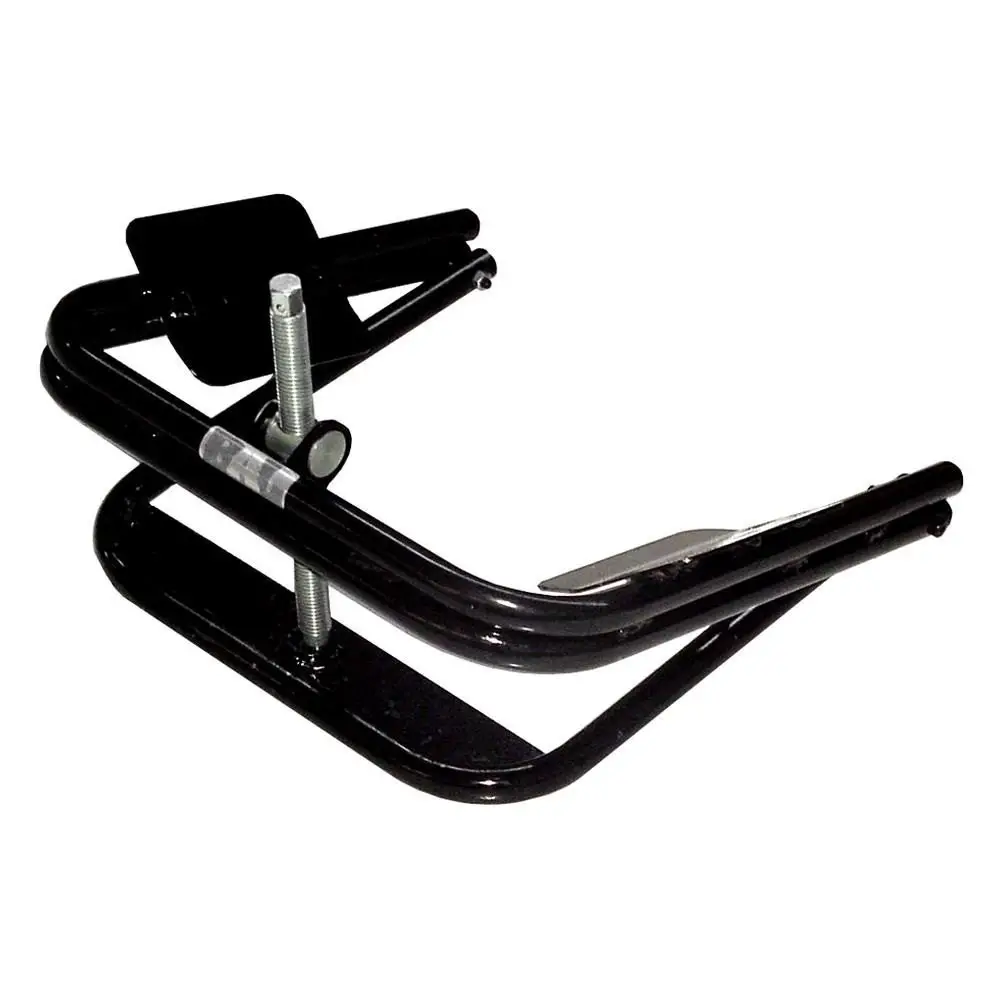 The BAL 28050 is a very convenient mechanical leveler that should only be used for extremely lightweight RVs. This is an unconventional leveler, but it’s favored by people with light RVs, and I’d be remiss if I didn’t at least try it out and review it.
The BAL 28050 is a very convenient mechanical leveler that should only be used for extremely lightweight RVs. This is an unconventional leveler, but it’s favored by people with light RVs, and I’d be remiss if I didn’t at least try it out and review it.
This leveler has a weight capacity of just 1700 pounds and fits 13”, 14”, and 15” wheels. The leveler itself has dimensions of 22 x 19 x 3.8” and weighs 14 pounds. It’s considerably more expensive than the regular block and ramp levelers.
The BAL 28050 comes with a ratchet wrench used to turn the drive screw and elevate the tires so you can position the leveler. As such, this method completely eliminates the need to gauge the desired height and then drive the wheels on the leveler. The only thing you have to do is use the wrench to lift the wheels.
One of the big issues here is the surface. This contraption tends to sink into soft ground so you can only use it on hard surfaces. Since you will be parking mostly on soft ground, this problem considerably restricts the device’s utility. Technically, it doesn’t need you to chock the other side of the wheel, but it’s still recommended that you do so to be safe.
Besides the aforementioned problems, my biggest issue with this leveler is that it can’t be used on dual-axle RVs. This device needs to be wrapped around a wheel to hoist it up. As such, even if you get two, you can’t put them side by side to hoist up both wheels simultaneously.
All other types of levelers — ramps and blocks — can be placed side by side to accommodate dual wheels. But the BAL 28050 can only be used on single-axle RVs. However, considering almost all dual-axle RVs are well over 1700 pounds in weight, you have two reasons not to use these levelers for dual-axles.
All things considered, this is a really convenient experimental leveling option. As of now, however, it has limited utility.
Pros
- You don’t have to estimate the desired height and then drive on the blocks. Simply hoist the device around the wheels and then lift it up like a jack.
- Extremely easy to use and time-efficient.
Cons
- Can only be used for extremely lightweight RVs.
- Can’t be used on soft grounds as it sinks.
- Ratcheting the wheels up can be difficult.
- Can’t be used on dual-axle RVs.
5. OxGord RV Camper Leveler Ramps
OxGord RV Camper Leveler Ramps is another ramp-style drive-on leveler. There are three height levels available with this ramp. As such, you need to determine how high you want the tire to go and then drive to the associated level. If you need to adjust the height, you simply have to reverse and drive to the correct level. There’s no need to get out of the vehicle, re-stack leveler blocks and then drive again.
The OxGord RV Camper Leveler Ramps is available in dimensions of 22” x 8” x 5”. It has a weight capacity of just about 11,000 pounds and can elevate wheels to a maximum of 3.8 inches. The best aspect of this leveler is that a single set includes two so you can level two tires simultaneously.
You should, however, beware that this leveler is not ideal for dual-axle RVs. First, it has a low-weight capacity of just 11,000 pounds and most dual-axle RVs are heavier than that when cargo is considered. But, more importantly, the ramps are too wide to accommodate the small gap between close-lying tires. You can, theoretically, try cutting the ramp down to size to accommodate the dual-axle wheels’ gap. But that’s not advisable as these ramps are already not highly durable and this could considerably damage them.
I would also recommend against using this on rocky surfaces because the edges of the ramp get chewed up and cracks start appearing. In short, it’s not very durable in the long run. You should, however, place a rubber mat under the ramp to increase its stability. And when you drive over it, be sure that your tires are firmly placed on the level and secured with wheel chocks. This will ensure that the tires don’t slip down.
These ramps are also not quite as stable as the Andersen Camper Leveler 3604. As such, it’s highly recommended that you use a stabilizer jack in conjunction with this leveler.
Pros
- Can be set up in a few short minutes.
- Don’t need to guess how to stack the blocks. Simply drive on the relevant level.
Cons
- Has a weight capacity of only 11,000 pounds.
- Not durable.
- Starts cracking when used on gravel.
Stabilizer Jacks & Why You Need Them
RV stabilizer jacks help prevent lateral or vertical movement of your vehicle. They are used mostly for travel trailers and fifth wheels and are usually available under the RV’s chassis. However, if your RV doesn’t come with a stabilizer jack, you’ll need to purchase one separately.
The primary purpose of using a stabilizer jack is leveling your RV in combination with leveling blocks. Stabilizer jacks add stability to an RV when you’re hoisting it up on leveling blocks. This prevents the RV frame from getting damaged.
Furthermore, RV stabilizer jacks are even more important for lighter vehicles. Heavier vehicles can use their own weight for stability. Lighter vehicles, however, shift around a lot when there’s movement inside.
RV Stabilizer jacks are used along with leveling blocks to add stability. Once you install them, you won’t feel a back and forth movement when in the RV. Furthermore, applying pressure on different parts of the RV won’t destabilize the entire structure.
Leveling blocks can level your RV, but they often cause instability. As such, stabilizer jacks are installed on the bottom of the RV to keep the rig stable.
Best RV Stabilizer Jacks for Your RV
6. Camco Olympian 44560
The Camco Olympian 44560 is one of the best stabilizer jacks on the market if you don’t require premium features, but this jack is not suitable for lifting the RV. You should use it purely for stabilizing purposes in conjunction with the leveling blocks described earlier in this article.
A single pack comes with 4 jacks, each of which can support up to 6,000 pounds of weight. The entire device is made of cast aluminum, so it is rust-proof, stainless, and durable. It can be used to adjust the height between 11” and 17”.
Even though these jacks can be adjusted between 11” and 17”, I found that they are actually stable for a lot less. If you go past the 13” point, stability is sacrificed considerably. However, in most cases, if you’re using them in conjunction with leveling blocks, you won’t need to go beyond 13”.
I did notice that the screws on these jacks were slightly loose. At first, I assumed it was because I had received a defective piece. But upon consulting with other users, I realized that the screws on this device are often loose. However, once downward pressure is applied, they tighten up and are no longer an issue. If you’re using several of them together, you should turn the screws evenly on all, so there’s no difference of pressure at various points in the RV.
The Camco Olympian 44560 does have a wide and solid base, however, which is ideal during rough weather conditions. It doesn’t move or become unstable even when it’s windy or raining. However, it can get a bit unstable on uneven surfaces, so you should only place them on leveler blocks or ramps, on even ground.
Pros
- Weather-resistant.
- The jack can be adjusted easily using the stabilizer pole.
- Easy to use.
Cons
- Turns unstable when you use it on uneven surfaces.
- Becomes unstable if you go past the 13” point.
- Screws are slightly loose.
- Cannot be used to lift the RV, only provide stability.
7. Eaz-Lift Camco 48855
The Eaz-Lift Camco 48855 is a 5th wheel stabilizer jack generally used for 5th wheel trailers with a height of 38.5” to 50”. Designed like a tripod, it can very easily be adjusted, and there are concave pads along the extension points to establish different heights. The height can be adjusted by simply moving the footpads in or out.
To determine the height needed, you simply have to measure from the ground to your kingpin and set up your jack accordingly. Once you have the correct height, you simply tighten the chain around it so it doesn’t move around. I am happy to say that this device almost completely stabilized my RV.
Even under intense cardio and aerobic activities, the RV remained stable and didn’t shake quite like it used to. The Eaz-Lift Camco 48855 is also weather-resistant. I have used it in places with a wind speed of 25 mph and more; it remained stable and the RV didn’t move at all.
Pros
- Ideal for stabilizing 5th wheels.
- Has a large tripod base that can keep the jack stable even in the roughest weather conditions.
- Leg chains are available to secure the legs in place and prevent them from overextending.
- The telescopic head can easily be adjusted to the right height.
Cons
- Over time and continued exposure to the sun, the tubing can start rusting.
- Has limited applicability. Only meant for 5th wheels and other large RVs and motorhomes.
8. Libra RV Stabilizer 26020
The Libra RV Stabilizer 26020 is a set of 4 steel stabilizer jacks and a crank handle. They have a retracted height of just 4”, an extended height of 24”, and a total weight capacity of 5000 pounds per jack.
This is a unique way to stabilize an RV that’s being leveled via leveling blocks. The four scissor jacks can be used to secure four points of contact to ensure that the RV is stable in all corners. The jacks can be easily raised or lowered using the provided crank handle. However, since you have to secure each point on the RV, it can also be quite time-consuming.
Unlike some of the other jacks mentioned on this list, the Libra RV Stabilizer 26020 can be placed directly on soft ground. The wide bow-tie base ensures that the jack doesn’t sink even on soft ground. As such, it has wide applicability and can be used on all types of RVs.
The entire contraption took me about 20 to 30 minutes to set up properly. Following that, I haven’t had any trouble with stability. I even tried jumping up and down at several points in the RV but it remained completely stable. If you don’t mind the effort it takes to install four jacks at different points — after finding the correct point through trial and error — then this is the perfect stabilizer jack for you.
Pros
- Four independent leveling stabilizer jacks available in a single package.
- Each jack can be adjusted optimally to mitigate shaking.
- Easy to use.
- Can be used on soft ground as well.
Cons
- Takes quite a bit of time to install all the jacks in the correct location.
Which Factors to Consider when Buying RV Leveling Blocks?
When buying RV leveling blocks and jacks, you need to consider the following factors.
Durability
If your leveler suddenly splits or caves in, your RV will suddenly move to one side. Sudden momentum could throw the contents of the RV off balance and be potentially dangerous if you’re cooking or doing something sensitive. The RV’s frame might also get damaged.
To prevent something like this from happening, you need to ensure that your leveling blocks are durable. They should be able to withstand drastic climatic and temperature changes.
Weight Capacity
Different RV leveling blocks are meant for different weight capacities. Some leveling blocks can handle only a few thousand pounds whereas others can handle over 40,000 pounds of weight. You should get a leveler with a weight capacity at least twice as much as that of your RV, taking into consideration its passengers and contents.
Ease
Make sure that your leveler is easy to install and can be handled by a single individual. The easiest levelers simply need to be placed at the correct height and then driven over with the RV. However, there are some RV levelers that are more complicated than this.
Which Factors to Consider when Buying RV Stabilizer Jacks?
The following are some of the primary factors to consider when buying RV Stabilizer Jacks.
Lifting Capacity
A stabilizer jack is only as good as its lifting capacity, represented in tonnes. You need to take note of your RV’s total weight — including all passengers and contents — and get a stabilizer jack accordingly. Your jack won’t be lifting the entire RV, however, so it’s okay if its weight capacity is slightly lower than the total weight of the RV.
Material
The standard materials used in the construction of stabilizer jacks are steel and aluminum. Steel is usually cheaper than aluminum and is used most popularly. While steel jacks are fine for small cars, you should use aluminum jacks for large RVs since they are far more durable.
Clearance Height
Clearance Height is the total height of the stabilizer jack not in use. The jack will have to go under the vehicle at its clearance height before it can start working. You need to make sure that the jack’s clearance height matches the RV’s height from the ground.
Lifting Height
Lifting height, unlike clearance, determines how high the jack can go or how high the jack can lift your vehicle. The ideal lifting height is generally 18 to 20 inches.
Lifting Speed
Lifting speed relates to the speed with which the jack can lift your vehicle. You should get a jack with a high speed so that you don’t spend hours every time you want to level your RV. Most manufacturers don’t offer information on the jack’s lifting speed, so you’ll have to consult secondary sources and other users for information. If you can test the stabilizer jack before purchase, it would be ideal.
How Do RV Leveling Blocks work?
RV leveling blocks are set to the desired height and placed on the ground so they can add height to your RV. Some RV levelers can be stacked atop each other to get the desired height, while some are like ramps that can be driven over.
Can I Make My Own RV Leveling Blocks from Wood?
It is possible to make your own RV leveling blocks with some spare lumber. The length of the leveling pieces should be 8 to 10 inches on all sides with a thickness of 1 to 2 inches. First, you need to cut the planks to the desired size. Next, you need to add a screw eyelet on one side of the blocks and tie a rope or string around them so they can be pulled together and used as leveling blocks.
When using homemade planks as levelers, you should be extremely careful. You can’t know for sure how durable these planks would be. If they can’t handle the correct weight capacity, the RV could suddenly move aside and its frame couold be damaged.
How Many RV Leveling Blocks Do I Need?
If you have a single-axle RV, you will only need one set of RV leveling blocks, i.e., either 10 blocks or a single ramp. If you have an RV with tandem wheels, you’ll need two sets of leveling blocks.
However, it’s possible that you might need to level two wheels simultaneously — either one on front and one on back or two on one side. As such, you should keep twice the number of leveling blocks as you need for one wheel, just to be careful.
How to correctly level my RV?
Side-to-Side Leveling
- After placing the RV where you need it, level it from side to side.
- Place the leveling blocks on flat surface next to the RV’s rear bumper. This will give you an indication of which side of the RV needs to be leveled.
- Place the leveling blocks or lumber pieces next to the tires on the side in need of leveling and then pull the RV forward.
- Slide the blocks into the tire’s original position and build a ramp to the desired height.
- Back up the RV on the leveling blocks and make sure it is now completely level.
- To prevent the RV from rolling ahead, add some wheel chocks.
Front-to-Back Leveling
- Place the level either on the window sill or RV steps to determine the front-to-back levelness.
- A jack or landing gear can be used to raise or lower the RV until completely level.
- Lower the stabilizer jack until tight. Add blocks under the RV’s tires to level it from front to back.
Can I Use Stabilizer Jacks to Level RVs?
A lot of RVers try to use stabilizer jacks to level their RVs, but this can be very dangerous. Stabilizer jacks are only used to stabilize an RV; they don’t have the weight capacity to level RVs on uneven ground for an extended period.
Using stabilizer jacks to lift the wheels may damage the jacks or even damage the RV’s frame. Stabilizer jacks are used to add stability to the RV while you add levelers under the RV’s wheels.




